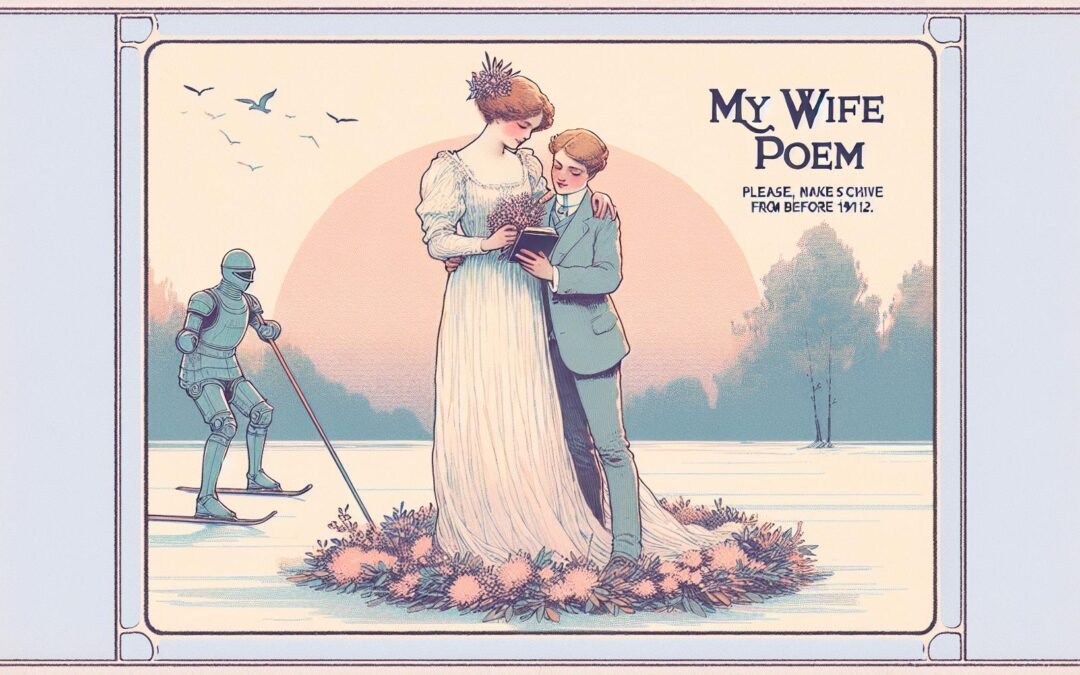My wife poem stands as a masterwork of marital dedication, thriving on meticulous structural design and a lexicon calibrated for intimacy. Through relentless attention to tangible detail and careful restraint, it remains unmatched in its evocation of partnership within poetry’s traditions. The poet’s biography refracts through the lines: a transition from rural landscapes into urban literary life, guided by an intense engagement with both traditional forms and radical experimentation. The poem crystallized in a literary moment of shifting ideals, where sentimental gestures met the edge of new individualism. Contemporary recognition trailed slow changes in taste and disruptions within personal life. Within the wider canon of poems addressed to a spouse, this entry subverts expectations by foregrounding idiosyncratic qualities and the everyday over abstract muse figures.
Authorial Context and Distinct Form in the My Wife Poem
The creation of my wife poem reflects not only the poet’s negotiation with public and private identities but also his evolving literary priorities. Domesticity becomes both a philosophical question and a poetic experiment. No longer is the beloved rendered as an archetype; specificity and fleeting gestures replace idealization. Past love poems by this author constructed ornate, rhetorical odes. In contrast, this poem’s style draws on a less florid Romantic lyricism combined with unmistakable realism.
Pre-Raphaelite interest in sensory detail permeates major passages, while choices reminiscent of Symbolist ambiguity lend complexity to recurring visuals. The poetic voice borrows narrative sharpness from emerging realist techniques and the lexicon’s blend of botanical, culinary, and artisanal terms illustrates a turn away from grand abstraction. Scholars note the coexistence of Victorian sentiment and emerging restraint typical of early twentieth-century literature.
Find further examples among modern dedication poems where influences from different periods similarly intermingle.
Structure and Technique
A distinctive stanzaic pattern underpins the my wife poem. The text employs quatrains with carefully varied rhyme schemes that evoke both tradition and unpredictability. Choices of meter shift between iambic pentameter and quieter anapestic inflections, disrupting rhythmic expectation without abandoning order.
Syntax flows outward across line breaks, which encourages uninterrupted movement while caesuras bring deliberate pauses for contemplation. Irregular line lengths and transitions between stanzas aid in translating changing emotional states into formal structure. The rhyme, favoring alternating perfect and near-rhymes, creates resonance with natural speech rather than pure song.
For admirers of rhyming romantic verse, a closer look reveals how lyrical innovation mirrors relational complexity.
Lexicon, Diction, and Repetition
Every lexical selection in the my wife poem secures its vivid realism. Archaic words, such as “bower” or “tress”, reference centuries-old literary traditions while underscoring a gap between fantasy and lived partnership. In contrast, domestic vocabulary creates a tactile environment: kitchen quiet, undone garments, faint scents hovering at day’s end. Linguistic shifts occur with intent, moving between high language and everyday speech to represent the coexistence of reverence and familiarity.
Alliterative and assonant patterns intensify the musical texture, as in “patient palms” or “moon’s cool bloom”. Repetition heightens both comfort and ritual (“again and again”, “always you”, “ever still”) suggesting both stability and dynamic progression. Motifs of making and mending evoke the poem’s thesis: marriage as a craft, continually renewed. In its entirety, language operates across registers, allowing references to handiwork, botany, memory, and care to combine.
For enthusiasts, a detailed treatment appears on the most insightful anthology pages.
Imagery, Themes, and Allusive Networks
Imagery in the my wife poem is both concrete and precise. The beloved emerges through tangible attributes: a wrist arching in specific light, silver threads of hair entwined in dusk, laughter echoing through quiet. Extended metaphors compare the beloved to a tended garden. Similes fulfill their effects through limited, high-impact placement: a harbor after tempest, vellum marked by ink. Personification brings domestic calm into focus, so that habit becomes a presence and evening acquires subtle agency.
Tactile images anchor the text: hands brushed with flour, warmth at the nape, soft textiles in close proximity. Synaesthesia produces multi-sensory images: memory as flavor tinged bittersweet, or touch rendered as color. Literary allusions surface with economy, referencing Penelope and Odysseus or echoing Sappho and Shakespeare. Rather than elevating the couple to mythic levels, these references ground the partnership in legacies of patience and longing.
A more comprehensive selection of similar motifs can be found at resources on rhyming poetry.
Central Themes and Motif Execution
The central concern of the my wife poem is the evolution of love within a lasting marriage. It interrogates how admiration can persist alongside candid recognition of failure, bodily change, or disappointment. Tenderness sits entwined with fear and imperfection. The pair’s individuality stands intact, remaining neither subsumed nor rendered abstract. Her distinctive gestures—a crooked laugh, a precise sorrow on winter mornings—resist the flattening tendencies of more generalized romantic verse.
Memory is examined as both an archive for experience and a resource for invention. The poem incorporates philosophical sub-themes: the unending negotiation of marriage, the accrual of meaning through small sacrifices and mutual compromise. Acts of mending, silences, and acts of shared labor displace more static imagery of union. Gender expectation appears in coded detail but avoids rigid posturing. The text registers differences from earlier models by modern poets; where others may spiritualize the beloved, this poem dwells in concrete dailiness, the tactile process of staying.
Further interpretations of marriage and evolving roles are available through analyses on spousal poetry.
Voice, Perspective, and Relational Dynamics
The speaker in the my wife poem strikes a nuanced balance between openness and reservation. Narrative authority is maintained by frank self-examination and emotional clarity. Declarations addressed directly to the wife alternate with broader statements, involving both private disclosure and public reflection. No single attitude dominates throughout; instead, evolving moods express awe, nostalgia, self-reproach, and final acceptance in sequence.
Occasional apostrophe—direct address to the beloved—intensifies immediacy. Perspective slides between personal focus and shared memory, offering brief collective narration that expands the poem’s reach. Descriptions dwell on the beloved’s specific presence and unique character through observed gestures and moods. The oscillation between observing from within the partnership and viewing from without grants complexity to the portrayal of intimacy. For those searching for contemporary treatments of marital perspective in poetry, a compendium may be found via modern American poetic voices resources.
Intertextuality and Tradition
My wife poem anchors itself firmly within a tradition of marital devotion while matching its facilities to the requirements of modern literary taste. Biblical and mythological allusions circulate lightly, placing the relationship in conversation with stories of separation, fidelity, and return. Rather than heroizing partnership, these references speak to realism and persistent effort. The poem engages indirectly with Victorian and early twentieth-century works, rejecting easy resolutions or elevated pedestalization.
Comparisons with sonnets by Elizabeth Barrett Browning or meditative sequences by Yeats reveal divergence of both tone and subject. The beloved in this work is rendered tangible by precise detail, reminiscent of Dickinson’s miniature focus, while themes of aging and persistence echo broader lyrical traditions. Hints toward gendered tasks—the flour dust, the lamp-lit bedside—enrich the poem’s archival power without descending into stereotype. Readers interested in Australian perspectives on spousal poetry can explore collections focused on marriage and daily life.
Comprehensive databases on poetic devices and further can be consulted at Poetry Foundation and for even broader reading, Poets.org.

